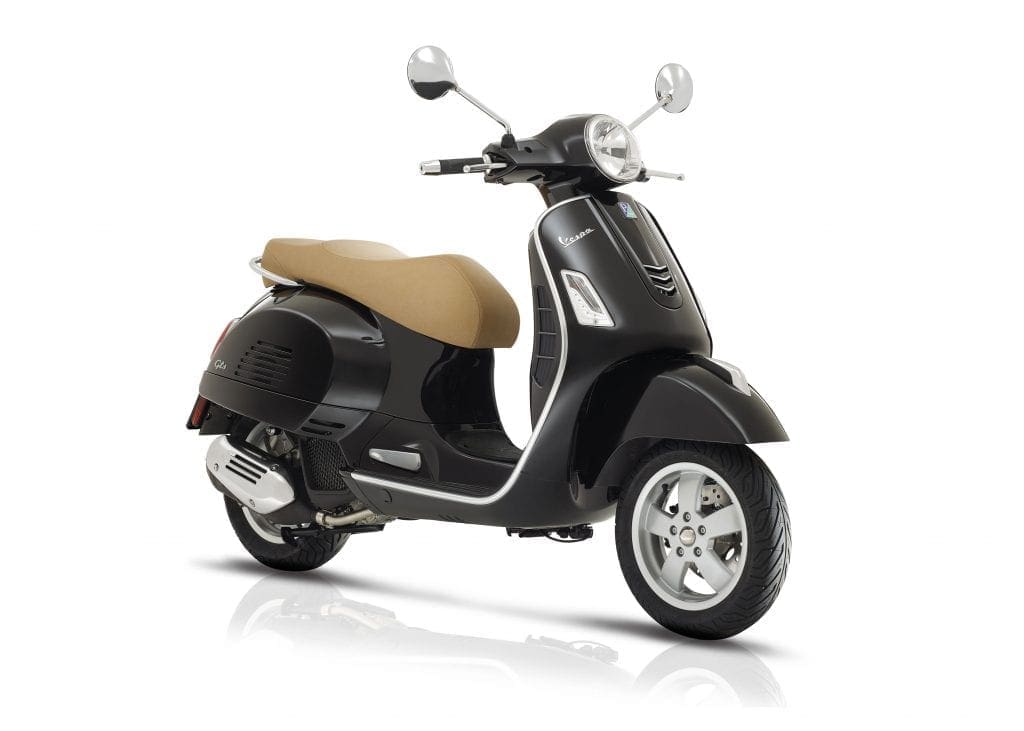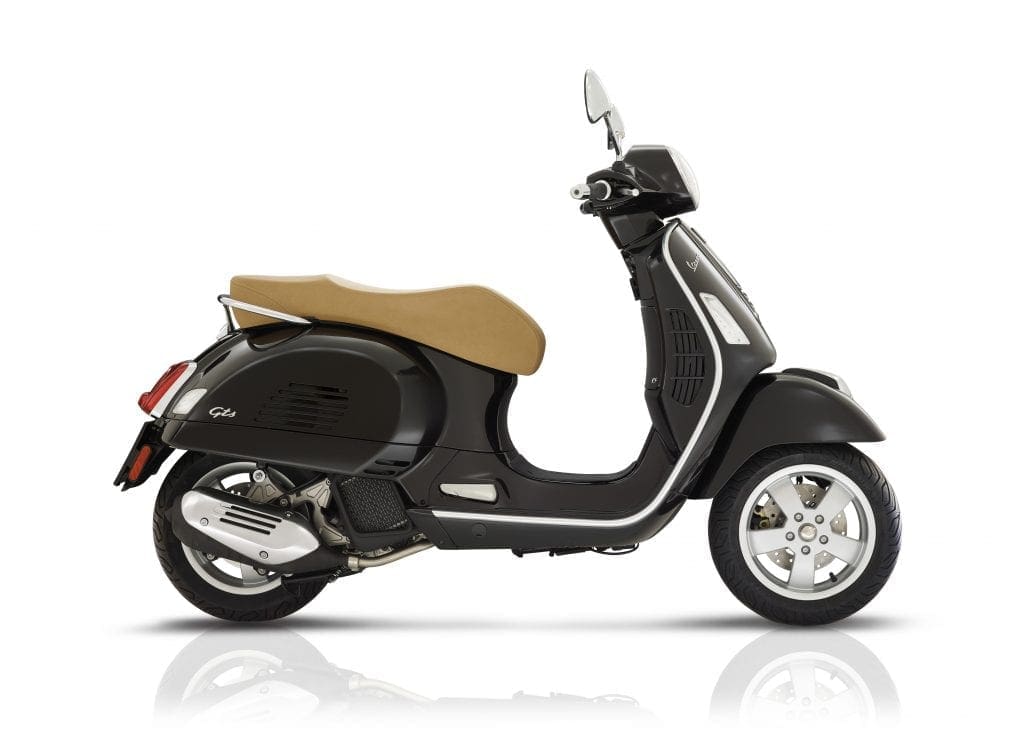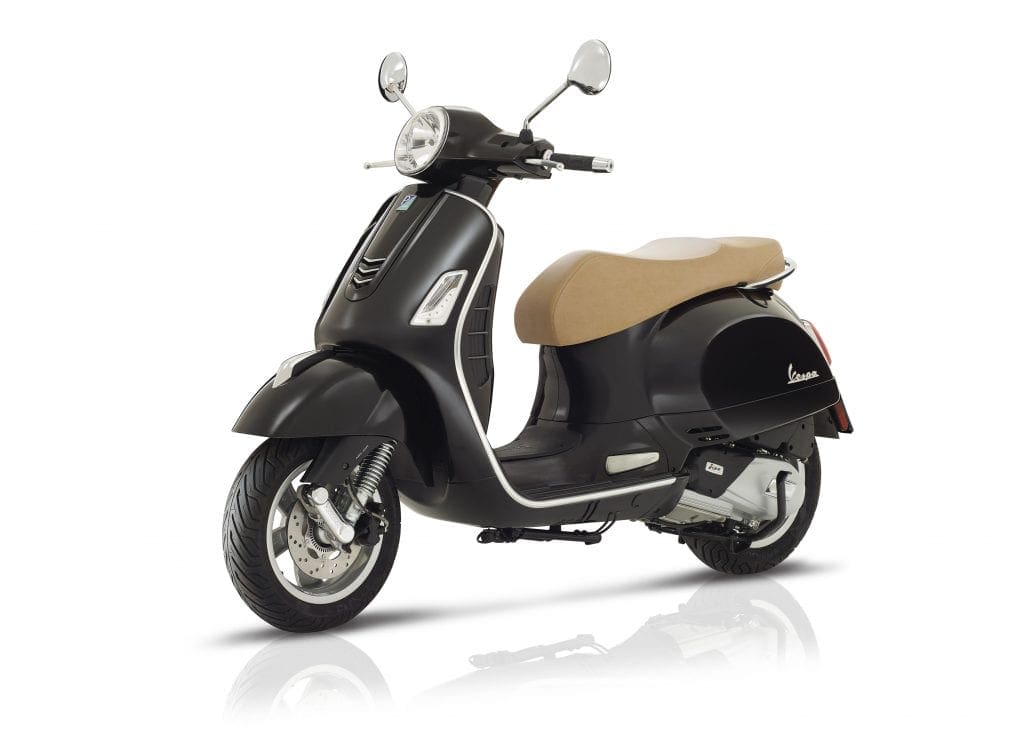Vespa GTS has been revamped with the adoption of the ultra-modern and technological i-get powerplant in its most advanced version with liquid cooling, electronic injection, 4-valve timing and, for the first time on a Vespa, the “Start and Stop” system. Two engine sizes are available: 125 and 150 cc, both Euro 4.
Engine:
On Vespa GTS the new family of i-get engines arrives, available in 125 and 150 cc displacements with electronic fuel injection, four valve timing and liquid cooling. These are engines at the top of their respective categories in terms of performance and environmental friendliness.
Start & Stop Tech:
And the new Piaggio patented Start & Stop system called RISS (Regulator Inverter Start & Stop System) makes its début on the Vespa. This system does away with the traditional starter motor, which is replaced by a brushless “direct mount” electrical unit, in other words, installed directly on the crankshaft. The Piaggio Start & Stop automatically switches off the engine 3 to 7 seconds after the vehicle stops (depending on whether or not the engine has reached the correct operating temperature). A slight twist of the throttle instantly restarts the engine, in complete silence, given the absence of the traditional starter motor. If the side stand is lowered or if the tilt sensor is activated, the ECU bypasses the Start & Stop function, in other words, the engine switches off and does not restart automatically.
Testing:
In the initial testing phases alone more than one million kilometres were logged in the intense search for reliability. Each and every one of the components on the new engines, from the exhaust to the internal design of the gearbox cover, all the way to the air filter, has been designed to make the ride smoother, quieter and more comfortable, and to increase the life of the engine. A large portion of the Piaggio technical work had to do with the maniacal attention to reducing friction through the introduction of bearings on every rotating part, in the timing and in the crank gear geometry, with the cylinder axis shifted to reduce losses due to friction on the piston. The mechanical noise of the new i-get engines is also extremely low thanks to a reduction in play and an optimisation of the materials and shapes.
More new parts:
There are many completely new parts on the family of i-get engines:
– thermodynamics (head, cylinder, piston, rocker timing with rollers); also, all of the parts in motion have been optimised to reduce weight and operating friction.
– the crankshaft, for a clear reduction in vibrations
– starter: no longer the classic gear drive starter motor, but now an electric “direct mount” type “brushless” motor on the crankshaft. The result is the total absence of friction in order to obtain a quiet, durable and reliable starter.
– cooling system, with radiator built into the engine: this reduced the overall weight of the vehicle and the warm-up times (thermal management), with clear benefits in terms of consumption and emissions.
– the gearbox cover, to reduce the noise even more.
– the latest generation double toothed belt to minimise passive losses, once again all to the advantage of consumption and emissions.
– the gearbox setting that improves rideability, performance and consumption.
– the air filter, which improves filtering action to reduce intake noise.
– new built-in engine electronic control unit with the S&S management part (Alternator, S&S Inverter, RISS), entirely developed by Piaggio.
Power:
The 125cc version is credited with power of 9 kW (12hp) at 8,250 rpm, whereas the more powerful 150 cc puts out 11 kW (15hp) at 8,250 rpm. These are numbers that translate into quick engines on the road, riding conditions characterised by frequent starts and stops which require elasticity, quick acceleration and a smooth ride. These characteristics are ensured by excellent torque (11.1 Nm at 6,750 rpm for the 125 cc and 14 Nm at 6,500 rpm for the 150 cc) which provide Vespa GTS with excellent acceleration both from a stop and in motion.
Service intervals:
The new engines also guarantee lengthy service and maintenance intervals. Fluids and filters are changed every 10,000 km and valve clearance only needs to be adjusted every 20,000 km.
Consumption:
Overall fuel consumption benefits from the optimisation of each and every component: mileage on the WMTC cycle reaches 42.4 km/l for the Vespa GTS 125 (41.1 km/l for the GTS 150).
The large Vespa style.
The Vespa GTS evolution has always followed the trend of tradition, maintaining that magical balance between tradition and modernism in the lines of the body, strictly in steel. Vespa GTS still maintains the distinctive traits that are so characteristic of the large body Vespa, but it also has numerous and important aesthetic updates.
New safety features.
The Piaggio Group was the first company in the world to introduce electronic systems on scooters which were once available only on the best motorcycles, such as ASR (available on the GTS 300 version) and ABS, which also equip the GTS 125 and 150. Each wheel has a revolution detection system – a sensor and a tone wheel – which instantly reads the speed and deceleration of the wheel with respect to that of the vehicle. The sensors dialogue with a 2-channel hydraulic control unit which activates the ABS system if one of the two wheels decelerates abruptly with respect to the vehicle, avoiding locking and ensuring stability and efficient braking even on road surfaces with a low friction coefficient.
All Vespa brand accessories and style compliments are available online. In fact, at VESPA.COM, the point of reference for Vespa fans all over the world, the display windows of the Vespa Store are open, a web space that makes all of the Vespa lifestyle collections available to enthusiasts. At Vespa Store the vast range of garments, gift items and accessories, conceived and designed based on the most classic Vespa iconography, is available to anyone who wants to live in Vespa style, dress with informal elegance and surround themselves with high quality items that are reminiscent of timeless shapes.
Vespa GTS 125 e 150- Technical Specifications
| ENGINE | ||
| Type | Single cylinder, 4-stroke Piaggio i-get with “Start & Stop” system | |
| Displacement | 124.7 cc | 155.2 cc |
| Bore x Stroke | 52 mm / 58.7 mm | 58 mm / 58.7 mm |
| Max Power at crankshaft | 9 kW / 8250 rpm | 11 kW / 8250 rpm |
| Max torque | 11.1 Nm / 6750 rpm | 14 Nm / 6500 rpm |
| Fuel system | Electronic injection | |
| Ignition | Electronic with variable advance | |
| Cooling system | Liquid | |
| Lubrication | Wet sump | |
| Gearbox | Twist-and-go CVT with torque server | |
| Clutch | Automatic centrifugal dry clutch | |
| VEHICLE | ||
| Bearing structure | Sheet metal with welded reinforcements | |
| Front suspension | Single arm suspension with coil spring and hydraulic shock absorber | |
| Rear suspension | Double hydraulic shock absorbers with adjustable preload with 4 settings | |
| Front Brake | Hydraulically operated 220 mm stainless steel disc | |
| Rear brake | Hydraulically operated 220 mm stainless steel disc | |
| 2-channel ABS system | ||
| Front tyre | Tubeless 120/70 – 12″ | |
| Rear tyre | Tubeless 130/70 – 12″ | |
| DIMENSIONS | ||
| Length/Width | 1930/755 mm | |
| Wheelbase | 1370 mm | |
| Saddle height | 790 mm | |
| Fuel tank capacity | 7 litres | |
| Emissions compliance | Euro 4 | |







